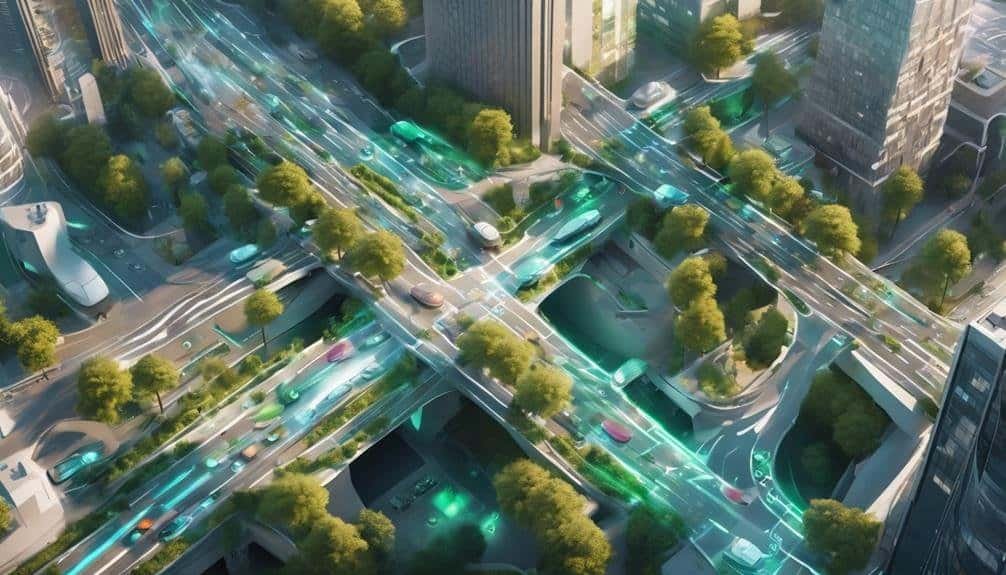AI in Urban Planning
Have you ever wondered how artificial intelligence is reshaping the way cities are planned and developed?
Imagine a world where intricate urban challenges are met with precision and efficiency.
Through the lens of AI, solutions emerge that could revolutionize the very fabric of our urban landscapes.
From optimizing traffic flow to predicting future growth patterns, the possibilities seem limitless.
Join in as we explore the realm where technology meets city planning, and discover the transformative potential AI holds for our urban futures.
Key Takeaways
- Enhance urban efficiency and decision-making with AI algorithms.
- Streamline processes like land use optimization and transportation planning.
- Foster citizen engagement through AI tools like virtual reality simulations.
- Ensure ethical AI integration and unbiased decision-making in urban development.
AI Applications in Urban Planning
Incorporate AI technology into urban planning processes to enhance efficiency and decision-making capabilities. Urban transformation can be significantly accelerated through the strategic integration of AI. By utilizing AI algorithms and machine learning models, urban planners can analyze vast amounts of data to gain valuable insights into trends, patterns, and potential future scenarios. This enables more informed decision-making and facilitates the development of sustainable and resilient cities.
AI integration in urban planning can streamline processes such as land use optimization, transportation planning, and infrastructure development. Through AI-powered simulations and predictive analytics, planners can assess the impact of different urban development scenarios and make data-driven decisions to achieve optimal results. This innovative approach not only saves time and resources but also ensures that urban projects are aligned with the needs and preferences of the community.
Furthermore, AI can enhance citizen engagement in the urban planning process. By leveraging AI-powered tools such as virtual reality simulations and interactive platforms, city officials can gather feedback from residents in real-time, allowing for more inclusive and participatory decision-making. This fosters a sense of ownership among the community members and promotes collaborative efforts towards building smarter and more livable cities.
Data Analytics for Smart Cities
To propel urban planning further into the realm of innovation and efficiency, harness the power of data analytics for creating smart cities that thrive on strategic insights and proactive decision-making. By leveraging data visualization techniques and predictive modeling applications, urban planners can gain valuable insights into various aspects of city management, from transportation to infrastructure development.
Data Analytics for Smart Cities:
Utilizing data analytics in urban planning allows for the efficient collection, analysis, and interpretation of vast amounts of data. By employing advanced data visualization techniques, planners can transform complex data sets into clear and actionable insights, aiding in the decision-making process.
Benefits of Data Analytics in Smart Cities:
| Benefits | Description |
|---|---|
| Enhanced Decision-Making | Data analytics enables evidence-based decision-making, leading to more effective urban plans. |
| Improved Resource Allocation | Predictive modeling applications help optimize resource allocation for better city management. |
| Real-time Monitoring and Analysis | The ability to monitor and analyze data in real-time allows for quick responses to city challenges. |
Traffic Management Solutions
You can revolutionize urban traffic by implementing AI in traffic control systems. This includes optimizing traffic flow and reducing congestion. Smart signal systems can dynamically adjust traffic lights based on real-time conditions, improving traffic efficiency and safety.
Real-time congestion analysis using AI can provide actionable insights to urban planners. This helps them make informed decisions for better traffic management.
AI in Traffic Control
Implementing AI technology in traffic control systems revolutionizes urban mobility by optimizing traffic flow, reducing congestion, and enhancing overall transportation efficiency. AI in traffic control enables real-time adjustments based on traffic conditions, leading to smoother traffic flow and decreased travel times.
By analyzing data from various sources such as cameras, sensors, and GPS systems, AI can predict traffic patterns, identify bottlenecks, and suggest alternative routes to alleviate congestion. Furthermore, AI algorithms can optimize traffic signal timings dynamically, prioritizing high-traffic routes during peak hours to keep vehicles moving efficiently.
This proactive approach to traffic management not only improves the daily commute for individuals but also contributes to a more sustainable and eco-friendly urban environment.
Smart Signal Systems
Incorporating smart signal systems into urban infrastructure revolutionizes traffic management solutions by dynamically optimizing signal timings to enhance overall transportation efficiency. Signal optimization plays a crucial role in reducing congestion and improving the flow of vehicles, ultimately leading to a more sustainable and organized urban environment. Intersection management is streamlined through the utilization of real-time data and AI algorithms, allowing for adaptive signal control based on traffic conditions. By implementing these smart signal systems, cities can significantly reduce travel times, decrease fuel consumption, and minimize carbon emissions. The future of urban planning lies in embracing technological advancements that enhance the functionality and effectiveness of transportation systems.
| Benefits of Smart Signal Systems | |
|---|---|
| 1. Reduced Congestion | 2. Improved Traffic Flow |
| 3. Lower Emissions | 4. Enhanced Safety |
| 5. Increased Efficiency | 6. Better Urban Planning |
Real-time Congestion Analysis
Smart signal systems pave the way for real-time congestion analysis, a crucial aspect of traffic management solutions that utilizes AI to optimize traffic flow and reduce urban gridlock. Real-time traffic monitoring enables the collection of data on current traffic conditions, allowing for immediate analysis and decision-making.
By incorporating congestion prediction techniques, AI algorithms can anticipate traffic bottlenecks and suggest dynamic adjustments to traffic signals in real-time. These advanced systems not only help in alleviating congestion but also contribute to overall efficiency and safety on the roads.
With the ability to adapt to changing traffic patterns instantly, real-time congestion analysis represents a strategic approach to managing urban traffic flow, making cities smarter and more responsive to the needs of commuters.
Sustainable Infrastructure Development
To achieve sustainable infrastructure development in urban planning, prioritize incorporating renewable energy sources and resilient design strategies. Sustainable development hinges on the integration of green infrastructure planning, ensuring that cities aren't only efficient but also environmentally conscious. By harnessing renewable energy sources such as solar and wind power, urban areas can reduce their carbon footprint and reliance on non-renewable resources.
Incorporating resilient design strategies is crucial for adapting to the challenges posed by climate change. This involves building infrastructure that can withstand extreme weather events and natural disasters, ensuring the long-term viability of urban systems. By investing in infrastructure that's both sustainable and resilient, cities can mitigate risks and enhance their overall quality of life.
AI plays a pivotal role in optimizing sustainable infrastructure development by analyzing data to identify areas for improvement and efficiency. Through real-time monitoring and predictive analytics, urban planners can make informed decisions that lead to more sustainable outcomes. By leveraging AI technologies, cities can enhance their infrastructure planning processes, ultimately creating more resilient and environmentally friendly urban environments.
Urban Design Optimization
To optimize urban design effectively, consider leveraging advanced technologies such as AI for insightful and data-driven enhancements in city planning and infrastructure development. When focusing on urban design optimization, incorporating AI can revolutionize the way cities are planned and developed. By utilizing AI tools, you can dive deep into urban density analysis and green space optimization, paving the way for more sustainable and livable cities.
Key Strategies for Urban Design Optimization:
- Implementing AI for Urban Density Analysis: By utilizing AI algorithms, you can efficiently analyze urban areas to determine optimal population distribution and resource allocation.
- Leveraging Data-Driven Insights: AI can provide valuable insights based on real-time data, enabling informed decision-making in urban planning processes.
- Prioritizing Green Space Optimization: AI can help identify underutilized areas that can be transformed into green spaces, promoting environmental sustainability and enhancing the quality of life for residents.
- Enhancing Infrastructure Efficiency: Through AI applications, you can streamline infrastructure development processes, improving connectivity and accessibility within cities while reducing environmental impact.
AI in Public Transportation
Enhance public transportation efficiency and passenger experience through the strategic integration of AI technologies in urban mobility systems. AI plays a pivotal role in transforming public transportation by optimizing fares and improving route planning. By leveraging AI algorithms, public transportation systems can analyze vast amounts of data to determine optimal fare structures based on factors such as demand, time of day, and passenger preferences. This enables transit agencies to offer dynamic pricing strategies that maximize revenue while ensuring affordability for passengers.
Moreover, AI-powered route planning enhances the overall efficiency of public transportation networks. By analyzing historical data, traffic patterns, and real-time information, AI algorithms can optimize bus schedules, train frequencies, and routing to reduce travel times and minimize congestion. This results in a more seamless and reliable transportation experience for passengers, ultimately increasing ridership and reducing carbon emissions.
Additionally, AI can assist in predicting passenger demand, allowing transit agencies to adjust services in real-time to meet fluctuating needs. By integrating AI into ticketing systems, transportation providers can offer personalized recommendations and incentives to encourage the use of public transportation. This not only improves the passenger experience but also contributes to sustainable urban development by promoting eco-friendly modes of transportation.
Real-time Urban Monitoring
Implementing real-time urban monitoring systems revolutionizes city management by providing immediate insights into key urban metrics and trends. Real-time environmental monitoring and urban mobility optimization are crucial aspects that shape the efficiency and sustainability of modern cities. Here's how real-time urban monitoring can enhance urban planning:
- Enhanced Decision-Making: Real-time data on environmental factors such as air quality and noise levels allow city officials to make informed decisions promptly.
- Improved Traffic Management: By analyzing real-time data on traffic flow and congestion, cities can optimize traffic signal timings and reduce commute times.
- Effective Resource Allocation: Real-time monitoring helps in efficiently allocating resources like energy and water based on current demand and consumption patterns.
- Early Issue Detection: Instant alerts from monitoring systems enable quick responses to issues like floods, accidents, or pollution, enhancing overall urban resilience.
Real-time urban monitoring not only streamlines day-to-day operations but also lays the groundwork for predictive analytics and proactive urban management strategies. By leveraging technology to capture and analyze data in real-time, cities can adapt swiftly to changing environmental conditions and optimize urban mobility for a sustainable future.
Climate Change Resilience
You can enhance climate change resilience in urban areas through data-driven urban design and AI for risk assessment.
By utilizing AI technologies to analyze data, urban planners can make informed decisions to mitigate the impact of extreme weather events and rising sea levels.
This strategic approach enables cities to adapt and build infrastructure that can withstand the challenges posed by climate change.
Data-Driven Urban Design
Utilizing advanced data analytics to inform urban design decisions is pivotal for bolstering cities' resilience against the impacts of climate change. By harnessing data visualization techniques and machine learning algorithms, urban planners can gain valuable insights to create sustainable and adaptive city layouts.
Consider the following key points:
- Data Visualization Techniques: Enhancing understanding of complex urban challenges.
- Machine Learning Algorithms: Predicting future climate scenarios and their effects.
- Urban Space Optimization: Maximizing land use efficiency for resilience infrastructure.
- Urban Mobility Trends: Adapting transportation systems to mitigate climate risks and improve accessibility.
Strategic integration of data-driven approaches in urban design empowers cities to proactively address climate change challenges and build resilient urban environments.
AI for Risk Assessment
Leveraging artificial intelligence for risk assessment in urban planning is essential for enhancing climate change resilience. By utilizing predictive modeling techniques, AI can help identify vulnerable areas, assess potential risks, and develop effective risk mitigation strategies. Through analyzing vast amounts of data, AI can provide valuable insights into how urban areas may be impacted by climate change, allowing for proactive planning and adaptation measures.
This innovative approach enables city planners to make informed decisions, prioritize investments, and implement strategies that enhance resilience to extreme weather events and other climate-related challenges. By integrating AI into risk assessment processes, urban planners can create more sustainable and resilient cities, better prepared to withstand the impacts of a changing climate.
AI for Zoning Regulations
Incorporating artificial intelligence into the development of zoning regulations offers a forward-thinking approach to urban planning that enhances efficiency and accuracy. AI for Zoning Regulations can revolutionize the way cities plan and manage their development. Here's why it's crucial:
- Enhanced Zoning Innovation: AI can analyze vast amounts of data to propose innovative zoning solutions that cater to the evolving needs of urban areas.
- Improved Regulatory Compliance: By leveraging AI, cities can ensure that zoning regulations comply with all legal requirements and standards, reducing the risk of legal challenges.
- Streamlined Decision-Making Process: AI algorithms can quickly process complex data sets and provide insights to policymakers, accelerating the decision-making process for zoning issues.
- Optimized Land Use: AI can help optimize land use by identifying underutilized areas and suggesting zoning changes that promote more efficient use of urban space.
Smart Waste Management Systems
To further enhance the efficiency and sustainability of urban environments, explore the implementation of Smart Waste Management Systems as a strategic solution for optimizing waste collection and disposal processes in cities. Waste reduction strategies and recycling initiatives are vital components of these systems, aiming to minimize the environmental impact of urban waste. By incorporating sensor technology into waste management, cities can revolutionize the way waste is collected and processed.
Sensor technology plays a crucial role in Smart Waste Management Systems by enabling real-time monitoring of waste levels in bins. This data allows for more efficient waste collection routes, reducing unnecessary trips and optimizing collection schedules. Additionally, sensors can detect contamination in recycling bins, improving the quality of recyclable materials and reducing the amount of waste sent to landfills.
Integrating recycling initiatives into Smart Waste Management Systems is essential for promoting a circular economy and reducing the reliance on landfills. By incentivizing recycling and making it easier for residents to participate, cities can significantly decrease the amount of waste generated. Smart bins equipped with sorting technology can automatically separate recyclables from general waste, streamlining the recycling process for both residents and waste management companies.
Energy Efficiency Planning
Enhance urban sustainability by strategically integrating energy efficiency planning into city development initiatives. When considering energy efficiency planning for urban areas, focusing on building insulation and the integration of renewable energy sources is crucial for long-term success.
Key Strategies for Energy Efficiency Planning:
- Building Insulation: Implementing proper insulation techniques in existing buildings and ensuring new constructions meet high insulation standards can significantly reduce energy consumption for heating and cooling purposes.
- Renewable Energy Integration: Incorporating renewable energy sources like solar panels, wind turbines, or geothermal systems into urban infrastructure can help cities reduce their reliance on fossil fuels and decrease overall carbon emissions.
- Smart Energy Management Systems: Utilizing AI-powered systems to monitor and optimize energy usage in buildings and public spaces can lead to more efficient energy consumption patterns.
- Community Engagement Initiatives: Educating residents and businesses about the importance of energy efficiency and encouraging sustainable practices can create a culture of environmental responsibility within the city.
Public Safety Enhancements
When optimizing urban environments, it is imperative to prioritize advancements in public safety to ensure the well-being and security of residents and visitors. Implementing AI technologies in urban planning can significantly enhance public safety through innovative approaches to crime prevention and emergency response. By leveraging AI algorithms and real-time data analysis, cities can proactively identify high-risk areas and allocate resources efficiently to prevent crimes before they occur.
To illustrate the impact of AI in public safety enhancements, consider the following table showcasing key benefits:
| Benefits of AI in Public Safety | Description | Examples |
|---|---|---|
| Crime Prediction | AI algorithms analyze historical crime data to predict potential crime hotspots, enabling law enforcement to increase patrols in those areas. | Predictive policing models in cities like Los Angeles have shown a significant decrease in crime rates. |
| Emergency Response Optimization | AI-enabled systems can analyze traffic patterns and emergency call data to optimize response routes for first responders, reducing response times in critical situations. | Cities like Singapore use AI to improve ambulance dispatch systems, ensuring faster emergency responses. |
| Surveillance Monitoring | AI-powered video analytics can enhance surveillance systems by automatically detecting suspicious activities and alerting authorities in real-time. | London's Metropolitan Police Service uses facial recognition technology to identify suspects in large crowds during public events. |
Community Engagement Strategies
You can enhance community engagement in urban planning by utilizing innovative tools such as virtual town halls and online surveys.
These platforms provide a convenient and accessible way for residents to voice their opinions and contribute to the planning process.
Virtual Town Halls
To foster greater community engagement, consider implementing Virtual Town Halls as a strategic approach in the urban planning process. Virtual engagement allows for inclusive decision-making, ensuring all voices are heard. Here are key reasons why Virtual Town Halls are beneficial:
- Increased Accessibility: Reach a wider audience regardless of physical location.
- Enhanced Participation: Encourage more community members to actively engage in discussions.
- Real-Time Feedback: Obtain instant input and reactions from participants.
- Cost-Effective: Save on resources compared to traditional in-person meetings.
Online Surveys
Implementing online surveys can revolutionize community engagement strategies in urban planning by gathering valuable insights from a diverse range of stakeholders efficiently. Online engagement allows for broader participation, reaching a larger demographic than traditional methods.
Through survey analysis, planners can swiftly identify trends, concerns, and preferences within the community. The data collected from online surveys provides a quantitative basis for decision-making, enhancing the accuracy and relevance of urban development plans.
Additionally, these surveys can be tailored to specific groups, ensuring that the feedback received is targeted and comprehensive. By leveraging online surveys, urban planners can streamline the community engagement process, improve transparency, and ultimately create more inclusive and sustainable urban environments.
Urban Growth Forecasting
Utilizing advanced data analytics and machine learning algorithms, urban growth forecasting offers a cutting-edge approach to predicting future development patterns in cities. This innovative technique leverages historical data and current trends to generate insights that can shape urban planning decisions effectively.
- Urban Population Trends: Urban growth forecasting allows for the analysis of population trends, helping city planners anticipate demographic shifts and plan resources accordingly.
- Forecasting Accuracy: By integrating AI algorithms, urban growth forecasting enhances the accuracy of predictions, enabling stakeholders to make informed decisions based on reliable data.
- Infrastructure Needs: Understanding future growth projections is crucial for determining the infrastructure requirements of a city, such as transportation networks, housing developments, and public services.
- Growth Projections: Through the use of AI tools, urban planners can create detailed growth projections that take into account various factors like economic indicators, social behaviors, and environmental considerations.
AI Ethics in Urban Development
As you explore the realm of AI Ethics in Urban Development, it's crucial to consider the intricate web of privacy concerns that arise when implementing artificial intelligence in urban planning.
By employing advanced bias detection techniques, urban developers can ensure that AI systems operate fairly and equitably, avoiding unintended discrimination.
Additionally, fostering strong community engagement strategies can empower residents to participate in decision-making processes, enhancing transparency and accountability in urban development initiatives.
Privacy Concerns in AI
Privacy concerns are a significant challenge in the field of AI ethics in urban development. These concerns pose a threat to data protection and ethical decision-making in cities that are increasingly reliant on AI technologies. Key points to consider include safeguarding personal information from unauthorized access, balancing security needs with individual rights, ensuring fair and transparent decision-making by AI systems, and developing regulatory frameworks to govern AI usage and protect privacy rights.
- Data Privacy: Safeguarding personal information from unauthorized access.
- Surveillance Concerns: Balancing security needs with individual rights.
- Ethical Use: Ensuring AI systems make decisions in a fair and transparent manner.
- Regulatory Framework: Developing policies to govern AI usage and protect privacy rights.
Bias Detection Techniques
To enhance the ethical integrity of AI systems in urban development, employing advanced bias detection techniques is crucial for ensuring fair and unbiased decision-making processes. Ethical considerations play a significant role in the development and deployment of AI algorithms within urban planning. By incorporating bias detection techniques, urban planners can identify and rectify any inherent biases present in the data or algorithms used.
Algorithmic transparency is key to understanding how decisions are made, allowing for accountability and scrutiny. Techniques such as fairness indicators, bias audits, and diverse dataset collection can aid in detecting and mitigating biases. Embracing these methods fosters a more inclusive and equitable urban development landscape, where decisions are made based on objective and unbiased criteria.
Community Engagement Strategies
Employing effective community engagement strategies is paramount for upholding ethical standards and fostering collaboration in the integration of AI in urban development. When considering AI Ethics in Urban Development, it's crucial to prioritize stakeholder engagement and actively seek community feedback. To achieve this, innovative approaches such as participatory workshops, online platforms, and focus groups can be utilized. These strategies not only ensure that diverse voices are heard but also help build trust and transparency in the urban planning process. By incorporating community input early on and throughout the development stages, urban planners can address concerns, identify opportunities, and co-create solutions that truly benefit the community.
- Prioritize stakeholder engagement
- Actively seek community feedback
- Utilize participatory workshops and focus groups
- Promote trust and transparency
Conclusion
As you reflect on the potential of AI in urban planning, it becomes clear that embracing these innovative technologies is crucial for shaping the cities of tomorrow.
By harnessing the power of data analytics, optimizing infrastructure, and enhancing public safety, AI offers a pathway towards sustainable urban development.
While navigating the ethical considerations involved, we must acknowledge the transformative impact AI can have in creating smarter, more efficient, and more inclusive urban environments.







